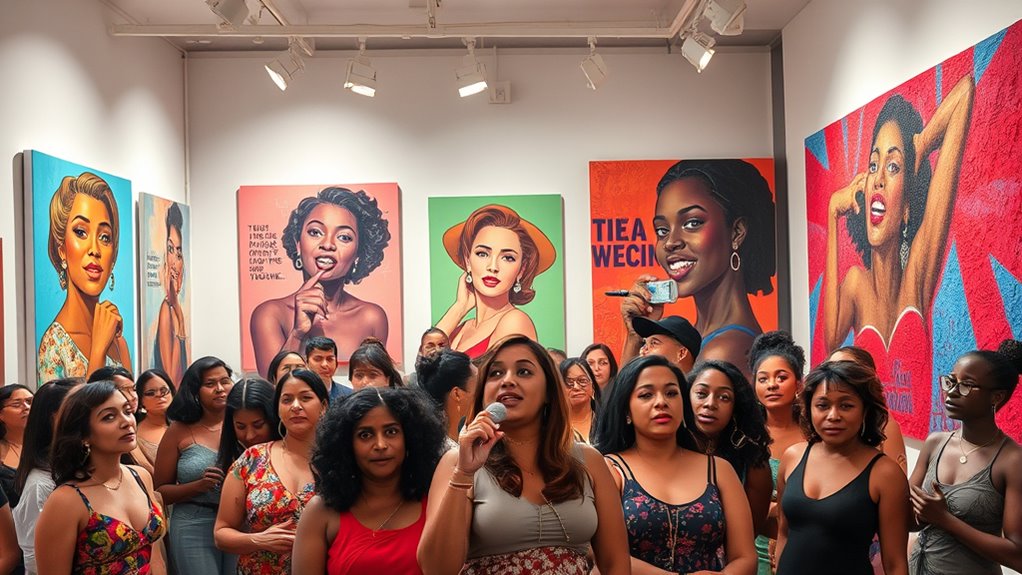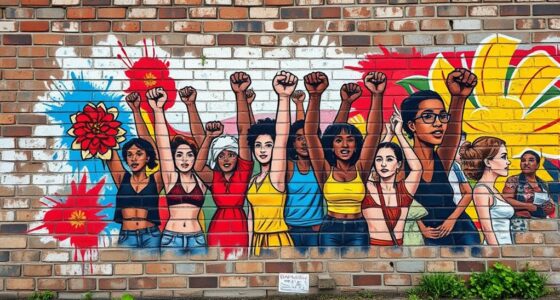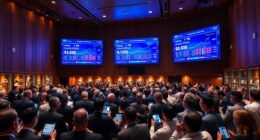The feminist art movement transformed the art world by empowering women artists to challenge traditional norms and showcase their unique voices. It introduced new media like textiles, performance, and multimedia to question gender roles and societal expectations. These artists pushed boundaries, revising art history and promoting social justice through powerful symbolism and activism. If you explore further, you’ll discover how this movement continues to shape contemporary art and inspire ongoing change worldwide.
Key Takeaways
- Women artists challenged male dominance and redefined artistic norms through innovative mediums and provocative themes.
- The movement elevated textiles, craft techniques, and everyday materials to fine art status, expanding artistic boundaries.
- Feminist artists used performance and multimedia to express female perspectives and confront gender stereotypes.
- Collective actions and iconic works like Judy Chicago’s *The Dinner Party* highlighted women’s achievements and history.
- The movement fostered intersectional approaches, addressing racism, social justice, and global women’s issues within art.
Origins and Context of the Feminist Art Movement
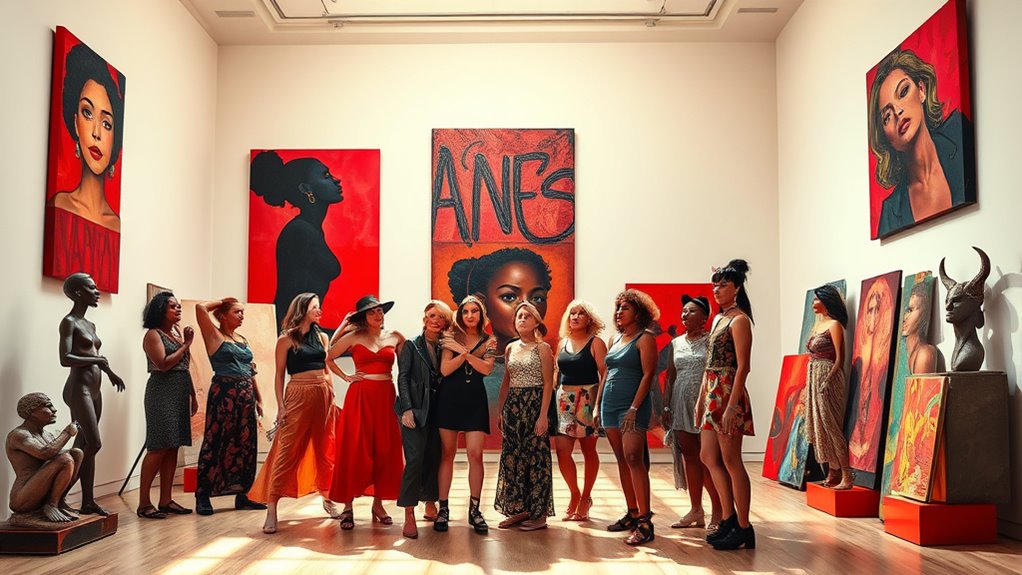
The Feminist Art Movement began in the late 1960s and early 1970s, emerging alongside the Second Wave of Feminism. During this time, society was experiencing major upheaval, including civil rights and anti-war protests. You’d see artists challenging the male dominance in art history and creating spaces for women and minority voices. Influenced by early feminist ideas and modernist utopias, the movement aimed to rewrite art narratives and break gender barriers. Key texts, like Linda Nochlin’s essay “Why Have There Been No Great Women Artists?” (1971), fueled these efforts. Social change was sweeping through the era, inspiring feminist artists to confront societal norms and stereotypes. This context created a fertile environment for transforming the art world and expanding representation for marginalized groups. The rise of feminist theory also provided intellectual backing for many artists’ activism and visual strategies. Additionally, the integration of social and political movements helped to foster a broader understanding of gender equality within the arts, especially as intersectionality gained recognition as a vital framework for understanding complex identities and oppressions.
Pioneering Women Artists and Their Works

You can see how Louise Bourgeois’s sculptures explore themes of female experience and psychological trauma through large, emotional forms. Eva Hesse pushes boundaries with her experimental, often fragile artworks that challenge traditional notions of art and femininity. Judy Chicago’s *The Dinner Party* transforms historical narratives, celebrating women’s achievements and asserting their rightful place in art history. Her work exemplifies how feminist artists have used innovative techniques to confront societal norms and inspire change.
Louise Bourgeois’ Sculptures
Louise Bourgeois revolutionized sculpture by transforming personal and feminist themes into powerful visual statements. Her work challenges traditional notions of femininity, using raw materials like marble and symbolic imagery to explore identity, sexuality, and trauma. Her sculptures often feature abstracted body parts—breasts, vulvas, phalluses—and evoke complex emotions rooted in her childhood and relationships. Notable pieces like “Maman” and “Cell” series highlight themes of protection, confinement, and psychological depth. Her pieces confront patriarchy and the male gaze, reshaping how women’s bodies and experiences are represented. To visualize her work, consider this table:
| Material | Theme | Symbolism |
|---|---|---|
| Marble | Feminine identity | Intimacy and vulnerability |
| Spiders | Maternal protection | Power and nurturing |
| Medical tools | Trauma and psyche | Reflection of inner struggles |
Additionally, her innovative use of sculptural techniques helped redefine contemporary art practices and inspired generations of women artists.
Eva Hesse’s Experimental Art
Eva Hesse revolutionized sculpture by pushing the boundaries of materials and techniques, creating works that are as emotionally raw as they are visually innovative. You’ll notice her use of industrial materials like polyester resin, fiberglass, and latex, which she manipulated to evoke organic forms and psychological moods. Her spontaneity meant letting materials guide her process, resulting in unpredictable textures and shapes. Notable works like *Repetition Nineteen III* and *Addendum* showcase her mastery of repetition, geometry, and experimentation. Hesse challenged minimalism’s austerity by adding tactile, imperfect, and personal elements. Her embrace of decay, chance, and messiness brought a new emotional depth to sculpture, breaking norms and inspiring subsequent generations to explore unconventional materials and methods. Her exploration of latex and fiberglass marked a significant shift from traditional sculpture techniques, emphasizing material innovation and experimentation. Additionally, her work exemplifies the impact of experimental art practices on contemporary sculpture.
Judy Chicago’s Dinner Party
- It features 39 place settings honoring women like Sacajawea and Virginia Woolf, each with hand-painted china and embroidered linens, symbolizing their unique contributions. The placement and design of each setting are carefully crafted to reflect the individual’s historical significance and personality.
- The triangular table signifies equality and strength among women, while the Heritage Floor inscribes the names of 998 women, acknowledging lesser-known figures. The arrangement emphasizes the importance of unity and collective achievement in feminist history.
- Bright vulvar motifs on plates celebrate female creativity and power, referencing biological and cultural femininity. These symbols serve as a visual affirmation of women’s reproductive and artistic capacities.
- The artwork’s intricate craftsmanship and symbolism challenge traditional art hierarchies, redefining women’s roles in history and art. The use of craft techniques like needlework and ceramics elevates these traditionally undervalued art forms to the status of fine art, challenging traditional art hierarchies.
Challenging Artistic Norms Through Mediums and Materials
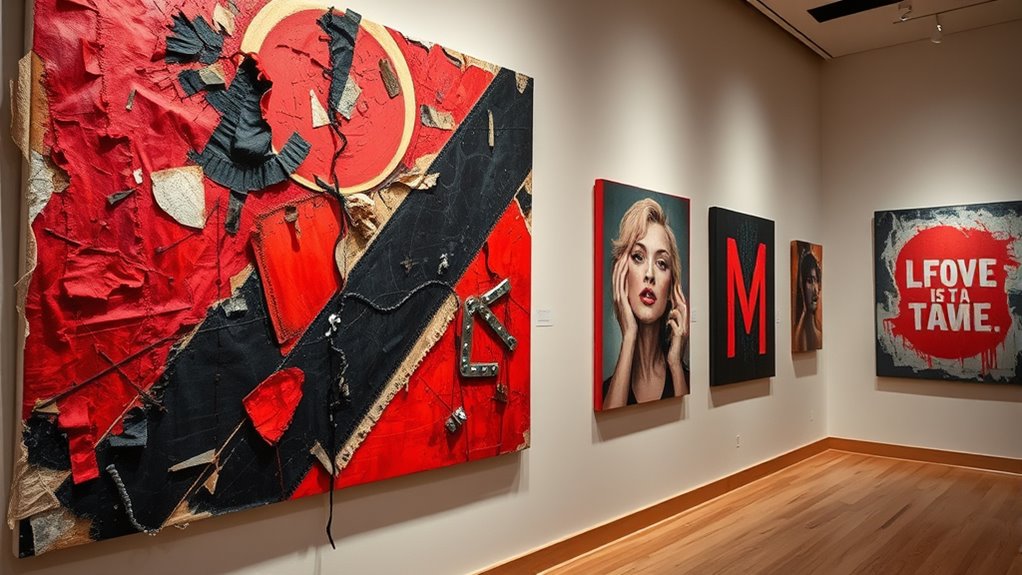
Feminist artists challenge traditional artistic norms by redefining the significance of mediums and materials, often using them to question established hierarchies and conventions. You see them reclaim textiles, weaving, and craft techniques once dismissed as domestic or lesser, elevating these to legitimate art forms that challenge the separation between “high art” and “craft.” They use everyday, feminine-associated materials—fabric, foam, found objects—to subvert traditional sculpture and embrace impermanence and vulnerability. Artists often employ materials as metaphors for women’s resilience and lived experiences, breaking material taboos with ephemeral or natural processes. This approach questions what’s valuable in art, emphasizing materiality and symbolism to resist societal norms and highlight women’s stories, transforming craft into powerful tools of resistance and empowerment. Additionally, their focus on materiality promotes a deeper understanding of the physical and emotional significance embedded in their work, encouraging viewers to reconsider the value of different artistic mediums. Recognizing the importance of artistic innovation, these artists continually push the boundaries of traditional art forms to foster social change. Moreover, by integrating cultural critique, they challenge the societal expectations imposed on women and their creative expressions, fostering a broader dialogue about gender and art. The use of symbolism in their work often carries layered meanings that invite personal and collective reflection.
The Role of Performance and Multimedia Art Forms
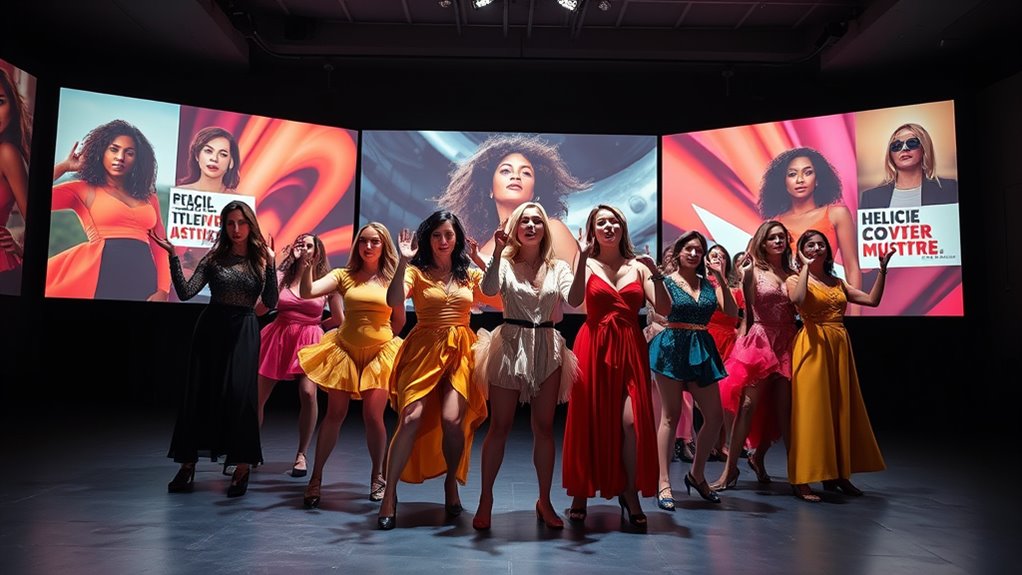
Performance and multimedia art forms challenge traditional mediums by using the body, video, and live interaction to express female perspectives. They push artistic boundaries, making personal and political stories more immediate and accessible. These approaches transform how feminist artists confront norms and expand the definition of art itself. Moreover, the influence of high-profile female artists’ earnings demonstrates the increasing recognition and financial success of women in the arts wealth of female singers.
Challenging Traditional Mediums
How did artists break free from traditional art forms to express their ideas more powerfully? They embraced performance and multimedia, challenging long-held notions of what art could be. This shift expanded the definition of fine art, incorporating new materials and perspectives. By doing so, feminist artists influenced future movements like Identity and Activist art. Here’s what made this approach impactful:
- They used alternative materials like textiles, breaking gender stereotypes in art.
- Performance art became a tool for personal and political expression.
- Multimedia forms, such as video, fostered experimental and innovative works.
- Artists from diverse backgrounds contributed to a global dialogue, broadening the movement’s reach.
- Understanding aura variations helped artists convey complex emotional and spiritual themes in their work. Additionally, this exploration of medium diversity allowed artists to challenge traditional hierarchies within the art world. Recognizing the importance of cultural context enabled artists to make their work more relevant and powerful in various societal settings. This challenging of mediums helped redefine art’s role in society and activism, pushing boundaries and inspiring change. Furthermore, the integration of digital technologies opened new avenues for creative expression and audience engagement.
Expressing Female Perspectives
Have you ever considered how women artists have used performance and multimedia to share their personal and political stories more directly? Performance art lets you experience immediate engagement, challenging traditional gallery norms by using the body to confront gender stereotypes. Feminist artists blend art and life, addressing issues like domesticity, sexuality, and inequality, with live, open-ended formats that defy rigid rules. Multimedia forms such as video, installation, and photography expand storytelling, documenting activism and creating immersive experiences. These approaches amplify women’s voices beyond elite circles and foster global dialogue. They often involve collaboration and participation, making the message more accessible and powerful. Artistic activism has played a crucial role in transforming the visibility and impact of feminist art worldwide, especially as understanding of resources and tools improves access to diverse mediums and audiences.
Expanding Artistic Boundaries
The feminist art movement markedly expanded artistic boundaries by embracing innovative performance and multimedia forms that challenged traditional notions of art. You’ll find that performance art became a powerful tool for direct engagement, allowing women to confront social norms head-on. Additionally, multimedia integration, such as video and digital art, pushed beyond conventional media, diversifying artistic expression. Feminist artists also used alternative materials like textiles, broadening the scope of what’s considered fine art. This experimental approach fostered creativity and challenged male-dominated traditions. Furthermore, the movement encouraged active listening and empathy within artistic collaborations, fostering a more inclusive and participatory creative environment. By utilizing experimental art techniques, feminist artists further expanded the possibilities for artistic innovation and social commentary, which collectively reshaped the art world’s landscape. The emphasis on truth and honesty in artistic expression further underscores the movement’s commitment to authentic representation and social critique, fostering a deeper connection between art and societal change.
Global Perspectives and Intersectionality in Feminist Art

Have you ever considered how feminist art reflects diverse cultural experiences across the globe? You’ll find that women artists are active everywhere—North America, Europe, Latin America, Asia, and Africa—each addressing local struggles. For example, Indian artists highlight caste and dowry issues, while Middle Eastern artists explore gender roles in Islamic contexts. International exhibitions and social media platforms amplify these voices, allowing artists like Priyanka Paul or Kruttika Susarala to challenge stereotypes and bring regional issues to global attention. Feminist art also confronts themes like race, ethnicity, class, sexuality, and religion, incorporating local myths and histories to resist oppression. By doing so, it emphasizes that women’s experiences are shaped by unique cultural and social realities, fostering a richer, more inclusive movement worldwide.
Major Events and Turning Points in the Movement
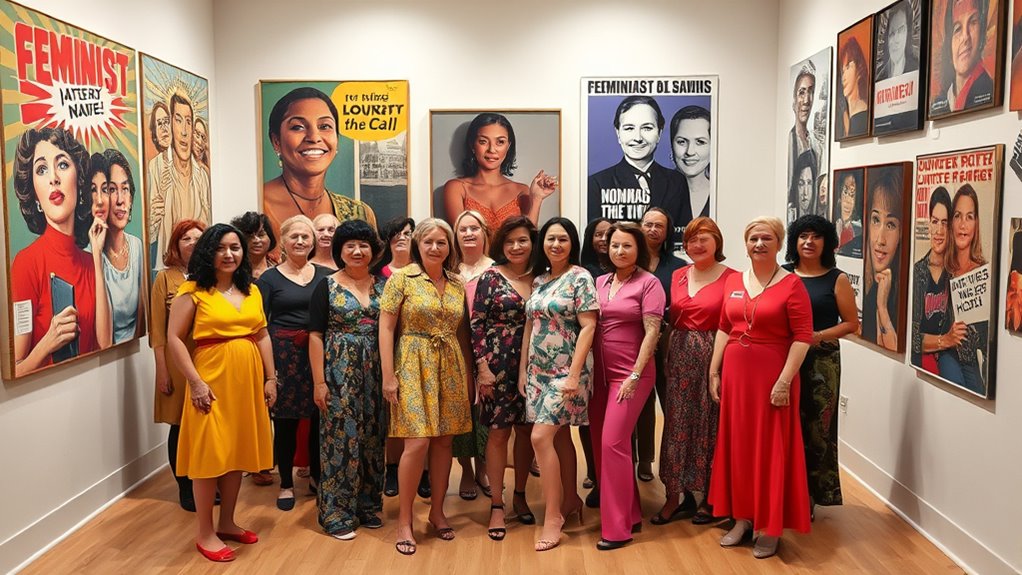
You see how landmark exhibitions and conferences spotlighted feminist art, fueling visibility and dialogue. Iconic protests and activism challenged institutions and pushed for representation, changing the art world’s landscape. Pivotal publications and media shaped public perception, amplifying the movement’s messages and expanding its reach.
Landmark Exhibitions and Conferences
Landmark exhibitions and conferences have played a pivotal role in shaping and advancing the feminist art movement by providing platforms for underrepresented artists and challenging traditional narratives. These events helped elevate feminist perspectives and foster dialogue within the art world.
- The “WACK! Art and the Feminist Revolution” exhibition in 2007 showcased nearly 300 works by 118 artists from 1965–1980, highlighting early feminist and proto-feminist art from figures like Louise Bourgeois and Yayoi Kusama.
- The Elizabeth A. Sackler Center for Feminist Art at Brooklyn Museum became a hub for exhibitions, education, and digital archives, promoting ongoing engagement with feminist art.
- The Women’s Caucus for Art Conferences since the 1970s created networking opportunities, scholarly discourse, and platforms for feminist theory.
- The Tate Papers analyzed major feminist exhibitions, emphasizing curatorial strategies and overlooked contributions, shaping critical discourse.
Iconic Protests and Activism
Iconic protests and activism have fundamentally shaped the feminist art movement by challenging conventional perceptions and demanding greater inclusion for women artists. The Guerrilla Girls, founded in 1985, used satire and bold visuals to expose systemic inequalities in art institutions. Women Artists in Revolution (WAR) pressured galleries and museums to showcase more women, inspiring similar groups nationwide. Early protests in the 1960s aligned with civil rights and anti-war movements, with feminist artists using performance art to challenge traditional art forms. Feminist collectives created alternative spaces, infiltrating the male-dominated art world. Their provocative campaigns, including posters and public performances, raised awareness and pushed for institutional change. These acts of activism fundamentally reshaped the art world, advocating for visibility, equality, and justice for women artists.
Pivotal Publications and Media
The feminist art movement gained momentum not only through protests and activism but also through influential publications and exhibitions that shaped its history. These works provided critical insights and elevated women’s roles in art.
- *Why Have There Been No Great Women Artists?* by Linda Nochlin questioned societal barriers hindering women’s recognition.
- Feminist art books celebrated women’s contributions, revealing their multifaceted roles as artists, muses, and models.
- Early feminist writings laid the groundwork for feminist art history, critiquing societal norms of the 1970s.
- Art and Feminism books explored themes like gender inequality and sexuality, reflecting the broader social context.
These publications, along with landmark exhibitions, helped legitimize feminist art and expand its influence globally.
Influential Writings and Theories Shaping Feminist Art
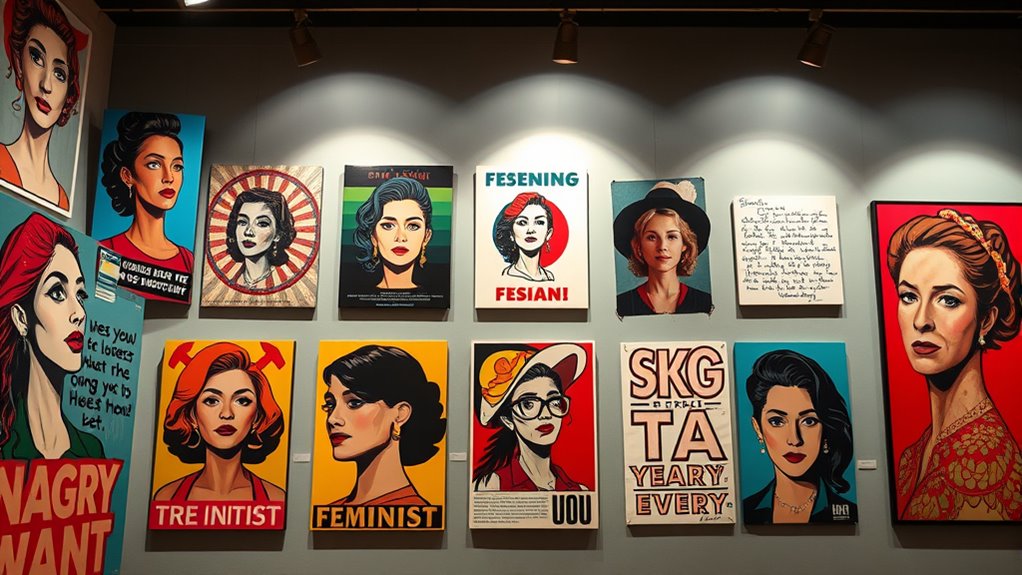
Feminist art has been profoundly shaped by a range of influential writings and theories that emerged largely in the 1970s, challenging traditional notions of art and gender. You’ll find that feminist art theory focuses on addressing gender disparity and societal norms, emphasizing themes like sexuality, family, and identity. Intersectionality plays a vital role, exploring how sexism intersects with racism and other oppressions. These writings also emphasize reclaiming female sexuality and rewriting male-dominated art history to include diverse perspectives. Key themes include social justice, narrative storytelling, empowerment, and the use of alternative media like textiles and performance. By engaging audiences and challenging stereotypes, these theories foster collective action, amplify marginalized voices, and expand artistic definitions, transforming how you understand gender, power, and representation in art.
The Movement’s Impact on Artistic Recognition and Opportunities
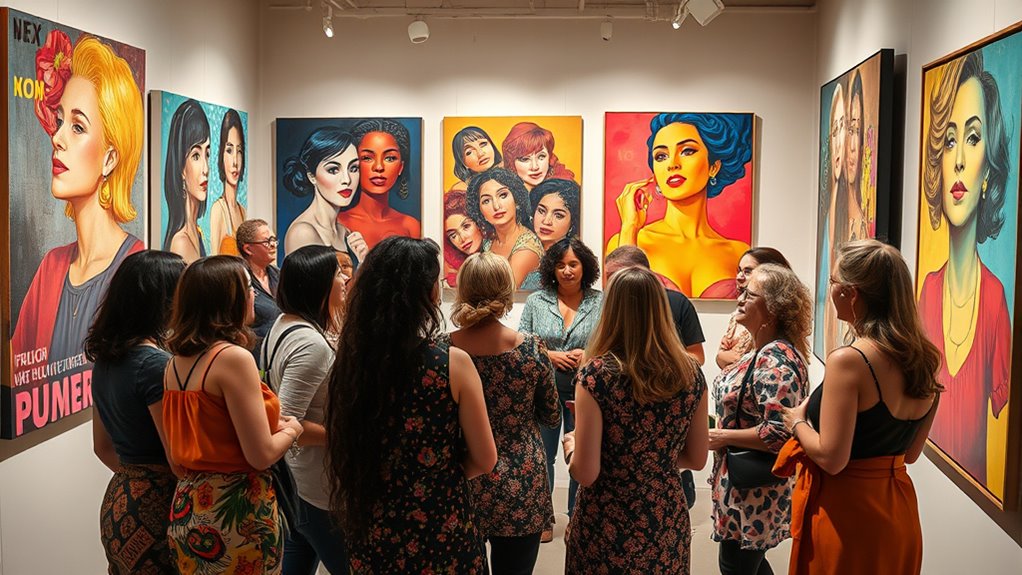
Feminist art has sparked significant changes in how artists gain recognition and access opportunities within the art world. You see, feminist artists challenged traditional norms by using unconventional media like textiles, performance, video, and body art, redefining fine art’s boundaries. This shift led to increased visibility through alternative venues and global collaborations, even though women remain underrepresented in mainstream exhibitions and collections.
- Women now earn a majority of fine arts degrees, yet face barriers in market recognition.
- Pioneering figures like Judy Chicago and Barbara Kruger broke new ground, influencing public perception.
- Feminist art fostered community and challenged stereotypes, promoting gender equality.
- Advocacy groups continue to push for equitable opportunities and recognition across the industry.
Continuing Legacy and the Evolution of Feminist Art Today

As feminist art continues to evolve, its legacy remains vibrant through museum exhibitions, international acclaim for overlooked artists, and community showcases celebrating resistance. In 2025, museums highlight women artists from past centuries, emphasizing their essential contributions. Nine late women artists gain global recognition, finally receiving the acknowledgment they deserve. During Women’s History Month, community art projects celebrate resistance and radical imagination, fostering dialogue and engagement. Feminist art continues to influence cultural attitudes, challenge stereotypes, and promote diversity worldwide. Artists now use alternative materials, digital platforms, and collaborative projects to expand expression and reach broader audiences. By critiquing societal norms and advocating for social justice, feminist art remains a powerful force for change, connecting women’s voices across cultures and generations.
How Feminist Art Transformed the Dialogue Around Gender and Creativity
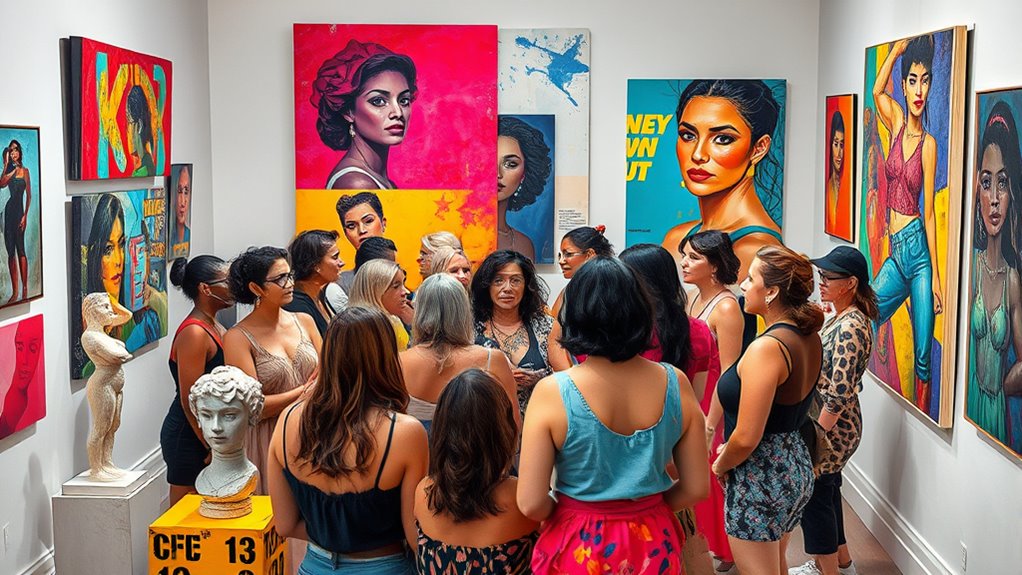
By centering women’s perspectives and social realities, feminist art has fundamentally reshaped how we recognize gender and creativity. It challenges traditional narratives by highlighting women’s lived experiences and exposing systemic inequalities. Feminist artists use diverse media, like textiles, performance, and video, to expand artistic boundaries and symbolize femininity and women’s labor. Their activism confronts institutional sexism, demanding greater representation and inclusion. Additionally, feminist art explores intersections of gender with race, class, and sexuality, fostering dialogue on identity and diversity. This approach questions binary notions of gender, opening space for fluidity and marginalized voices. As a result, feminist art transforms societal attitudes, encouraging a more nuanced, inclusive understanding of gender and creative expression.
- Challenges traditional narratives and highlights lived experiences
- Embraces diverse materials to redefine artistic boundaries
- Confronts institutional sexism through activism and critique
- Explores intersectionality, promoting inclusive gender dialogues
Frequently Asked Questions
How Did Feminist Art Influence Contemporary Gender Representation in Galleries?
Feminist art influences contemporary gender representation by challenging traditional stereotypes and highlighting women’s perspectives. You see galleries increasingly including works that address social and political gender issues, expanding narratives beyond male dominance. Feminist advocacy pushes institutions to revise policies, promote equality, and showcase more women artists. Although disparities remain, this movement encourages ongoing progress, inspiring galleries to prioritize diversity and reshape cultural attitudes toward gender in the art world.
What Challenges Did Women Artists Face Before the Feminist Movement?
Before the feminist movement, you faced limited access to training, restricted exhibitions, and societal expectations that confined your creative pursuits. You struggled with gender bias, often hiding your identity or working in less valued genres. You endured legal and social obstacles that undervalued your contributions, sacrificed personal ambitions due to domestic responsibilities, and operated outside mainstream institutions. These barriers made it challenging to gain recognition, advance professionally, and fully express your artistic voice.
How Did Feminist Art Address Issues of Intersectionality and Diversity?
You see how feminist art now actively addresses intersectionality and diversity by highlighting overlapping identities like race, gender, and class. It challenges traditional norms by giving voice to marginalized groups and showcasing their experiences through powerful imagery and symbolism. This approach promotes inclusivity, sparks conversations on representation, and encourages activism, ultimately fostering a broader understanding of social complexities and pushing the art world toward more equitable and diverse spaces.
In What Ways Has Digital Media Expanded Feminist Art Practices Today?
You see digital media’s power to connect and disrupt, expanding feminist art practices in unexpected ways. While algorithms sometimes marginalize content, social media opens space for diverse voices, fostering communities and activism. Online galleries and multimedia projects challenge traditional norms, allowing you to experiment freely. This digital landscape amplifies marginalized identities, addresses stereotypes, and encourages dialogue, making feminist art more accessible, inclusive, and dynamic.
How Do Current Feminist Artists Build Upon the Movement’S Historical Achievements?
You see that current feminist artists build on the movement’s achievements by gaining recognition for both historic and contemporary women artists. They use diverse mediums, innovative techniques, and digital platforms to challenge societal norms and promote equality. By engaging with communities and advocating for policy changes, you help reshape art history and foster a more inclusive, global dialogue about women’s contributions, ensuring their voices continue to inspire future generations.
Conclusion
You can’t deny that feminist art has revolutionized the art world, transforming it into a vibrant, inclusive space where women’s voices thunder louder than ever. By challenging norms and pushing boundaries, you now witness a creative landscape bursting with diversity and innovation. The movement’s impact is like a wildfire, igniting change across borders and inspiring generations. Together, you and countless others continue to shape a future where gender and art intertwine in unstoppable, breathtaking harmony.

